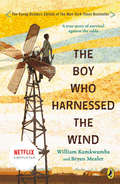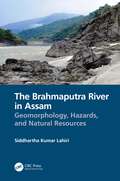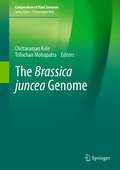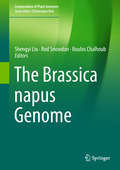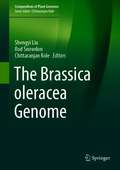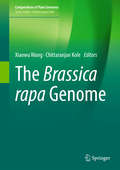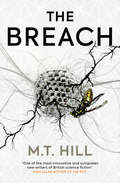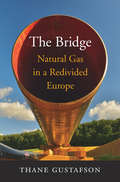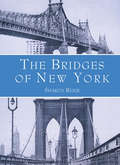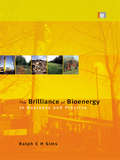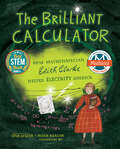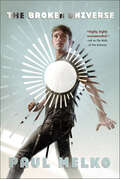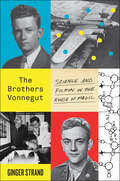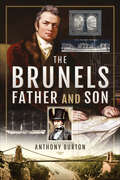- Table View
- List View
The Boy Who Harnessed The Wind
by William Kamkwamba Bryan Mealer Elizabeth ZunonWhen fourteen-year-old William Kamkwamba's Malawi village was hit by a drought, everyone's crops began to fail. Without enough money for food, let alone school, William spent his days in the library... <P> and figured out how to bring electricity to his village. Persevering against the odds, William built a functioning windmill out of junkyard scraps, and thus became the local hero who harnessed the wind. Lyrically told and gloriously illustrated, this story will inspire many as it shows how - even in the worst of times - a great idea and a lot of hard work can still rock the world.
The Boy Who Harnessed the Wind: Young Readers Edition
by William Kamkwamba Bryan Mealer Anna HymasNIMAC-sourced textbook
The Boy Who Harnessed the Wind: Young Readers Edition (P. S. Series)
by William Kamkwamba Bryan Mealer Anna HymasWhen a terrible drought struck William Kamkwamba's tiny village in Malawi, his family lost all of the season's crops, leaving them with nothing to eat and nothing to sell. William began to explore science books in his village library, looking for a solution. There, he came up with the idea that would change his family's life forever: he could build a windmill. Made out of scrap metal and old bicycle parts, William's windmill brought electricity to his home and helped his family pump the water they needed to farm the land.Retold for a younger audience, this exciting memoir shows how, even in a desperate situation, one boy's brilliant idea can light up the world. Complete with photographs, illustrations, and an epilogue that will bring readers up to date on William's story, this is the perfect edition to read and share with the whole family.
The Boy Who Made the World Disappear
by Ben Miller&‘A sheer delight for all kids both big AND small&’ Ruth Jones on The Night I Met Father Christmas 'Bubbles with warmth and mischievous humour . . . irresistible' Alexander Armstrong on The Night I Met Father Christmas'Wonderful, funny, magical' Chris Evans on How I Became a Dog Called MidnightEnter a world of wonder with an instant classic from comedian, actor and bestselling children's author, Ben Miller! Harrison tries his best to be good. He doesn&’t steal, he always shares with his sister and he never cheats at board games, but Harrison also has a BIG flaw . . . He can't control his temper!So when he&’s given a black hole instead of a balloon at a party, Harrison jumps at the chance to get rid of everything that makes him cross. But when it&’s not just things he hates that are disappearing into the black hole but things he loves, too, Harrison starts to realize that sometimes you should be careful what you wish for...An out-of-this-world adventure about twists of fate, time travel and troublesome black holes, Ben Miller's stunning storytelling is brought to life with beautiful illustrations from Daniela Jaglenka Terrazzini. Praise for Ben Miller:'A magical adventure' Sunday Express on The Day I Fell Into a Fairytale'Great for reading aloud' The Week Junior on The Day I Fell Into a Fairytale'A fire-side gem of a story' Abi Elphinstone on The Night I Met Father Christmas'Fabulous' Sunday Express on The Boy Who Made the World Disappear'Enchanting, funny and intriguing in equal measure' Philip Ardagh on The Night I Met Father Christmas'Each of [Ben&’s] five books is joyous and thoughtful' Red Magazine
The Boy Who Reached for the Stars \ El niño que alcanzó las estrellas
by Elio MorilloEl joven ingeniero conocido como “el mecánico del espacio” (@THESPACEMECHANIC) comparte su apasionante historia, desde su infancia en Ecuador hasta su trabajo en la misión Marte 2020 de la NASA.Elio Morillo tenía cuatro años cuando una serie de dificultades económicas y familiares obligaron a su madre a abandonar Ecuador con él. En Nueva York, y más tarde en Puerto Rico, gracias a los sacrificios y el apoyo incondicional de su mamá, Elio descubrió el poder transformador de la educación y el esfuerzo, así como de la amistad y la ayuda desinteresada de los desconocidos. Su determinación lo llevó a trabajar en el Laboratorio de Propulsión a Chorro de la NASA para la Misión Marte 2020, donde fue ingeniero de pruebas y operaciones de sistema para el rover Perseverance e Ingenuity, el helicóptero de Marte. El niño que alcanzó las estrellas es una muestra de que, si te lo propones, tú también puedes realizar tus sueños, así sean tan grandes como alcanzar las estrellas.---The young engineer known as "the space mechanic" (@THESPACEMECHANIC) shares his gripping story, from his childhood in Ecuador to his work on NASA's Mars 2020 mission.Elio Morillo was four years old when a series of economic and family difficulties forced his mother to leave Ecuador with him. In New York, and later in Puerto Rico, thanks to the sacrifices and unconditional support of his mother, Elio discovered the transformative power of education and effort, as well as friendship and the selfless help of strangers. His determination led him to work at NASA's Jet Propulsion Laboratory for the Mars 2020 Mission, where he was a system tested and operations engineer for the Perseverance rover and Ingenuity, the Mars helicopter. The boy who reached for the stars is a proof that, if you set your mind to it, you too can make your dreams come true, even if they are as big as reaching for the stars.
The Boy Who Reached for the Stars: A Memoir
by Elio Morillo"Heartwarming... infectious ... [Morillo's The Boy Who Reached for the Stars] is every bit the inspiration he means it to be." –Kirkus ReviewsThe engineer known as the “space mechanic” speaks to both our future and past in this breathless memoir of his journey from Ecuador to NASA and beyond.Elio Morillo’s life is abruptly spun out of orbit when economic collapse and personal circumstances compel his mother to flee Ecuador for the United States in search of a better future for her son. His itinerant childhood sets into motion a migration that will ultimately carry Elio to the farthest expanse of human endeavor: space.Overcoming a history of systemic adversity and inequality in public education, Elio forged ahead on a journey as indebted to his galactic dreams as to a loving mother whose sacrifices safeguarded the ground beneath his feet. Today, Elio is helping drive human expansion into the solar system and promote the future of human innovation—from AI and robotics to space infrastructure and equitable access.The Boy Who Reached the Stars is both a cosmic and intimate memoir spun from a constellation of memories, reflections, and intrepid curiosity, as thoroughly luminous as the stars above.
The Brahmaputra River in Assam: Geomorphology, Hazards, and Natural Resources
by Siddhartha Kumar LahiriThis holistic book covers the richest area in North East India in terms of both explored and foreseen reserves of fossil fuels and other natural resources. Using a multidisciplinary approach, GIS, and geospatial data gathered from different case studies included, this book helps readers develop a thorough understanding of a highly dynamic big river, the Brahmaputra, and use it as a comprehensive resource for further understanding the science of rivers. It discusses the causal factors of decadal-scale fluvial dynamics, the nature of fluvial dynamics, lateral variability of the older flood plains and neotectonics in the shallow subsurface, and the overall trend of basin evolution at different depths.
The Brain in Search of Itself: Santiago Ramón y Cajal and the Story of the Neuron
by Benjamin EhrlichThe first major biography of the Nobel Prize–winning scientist who discovered neurons and transformed our understanding of the human mind—illustrated with his extraordinary anatomical drawingsUnless you’re a neuroscientist, Santiago Ramón y Cajal is likely the most important figure in the history of biology you’ve never heard of. Along with Charles Darwin and Louis Pasteur, he ranks among the most brilliant and original biologists of the nineteenth century, and his discoveries have done for our understanding of the human brain what the work of Galileo and Sir Isaac Newton did for our conception of the physical universe. He was awarded the Nobel Prize in 1906 for his lifelong investigation of the structure of neurons: “The mysterious butterflies of the soul,” Cajal called them, “whose beating of wings may one day reveal to us the secrets of the mind.” And he produced a dazzling oeuvre of anatomical drawings, whose alien beauty grace the pages of medical textbooks and the walls of museums to this day.Benjamin Ehrlich’s The Brain in Search of Itself is the first major biography in English of this singular figure, whose scientific odyssey mirrored the rocky journey of his beloved homeland of Spain into the twentieth century. Born into relative poverty in a mountaintop hamlet, Cajal was an enterprising and unruly child whose ambitions were both nurtured and thwarted by his father, a country doctor with a flinty disposition. A portrait of a nation as well a biography, The Brain in Search of Itself follows Cajal from the hinterlands to Barcelona and Madrid, where he became an illustrious figure—resisting and ultimately transforming the rigid hierarchies and underdeveloped science that surrounded him. To momentous effect, Cajal devised a theory that was as controversial in his own time as it is universal in ours: that the nervous system is comprised of individual cells with distinctive roles, just like any other organ in the body. In one of the greatest scientific rivalries in history, he argued his case against Camillo Golgi and prevailed.In our age of neuro-imaging and investigations into the neural basis of the mind, Cajal is the artistic and scientific forefather we must get to know. The Brain in Search of Itself is at once the story of how the brain as we know it came into being and a finely wrought portrait of an individual as fantastical and complex as the subject to which he devoted his life.
The Brassica juncea Genome (Compendium of Plant Genomes)
by Chittaranjan Kole Trilochan MohapatraThis book is the first comprehensive compilation of deliberations on elucidation and augmentation of the genome of Brassica juncea, one of the leading oilseed crops of the world, popularly called as brown mustard, Indian mustard, Chinese mustard, or Oriental mustard. It includes discussions on genepools; genetic diversity and its characterization; classical genetic and traditional breeding; basics and application of heteroploidy; techniques and applications of introgressive hybridization; in vitro culture for micro-propagation, somatic mutation, somatic embryogenesis, and somatic hybridization; genetic engineering including genetic transformation and gene silencing; and molecular genetic mapping and mapping of genes and comprehensive delineations on genome sequencing and comparative genomics; resequencing for elucidation of origin and diversity; large-scale genome analysis; plastid genome sequence; transcriptomics; metabolomics; proteomics; evolutionary genomics; role of regulatory genes in development and adaptation and their utilization in trait improvement; precise breeding for yield, quality, and resistance to biotic and abiotic stresses; and prospects of genome editing.
The Brassica napus Genome (Compendium of Plant Genomes)
by Shengyi Liu Rod Snowdon Boulos ChalhoubThis book describes how the genome sequence contributes to our understanding of allopolyploidisation and the genome evolution, genetic diversity, complex trait regulation and knowledge-based breeding of this important crop. Numerous examples demonstrate how widespread homoeologous genome rearrangements and exchanges have moulded structural genome diversity following a severe polyploidy bottleneck. The allopolyploid crop species Brassica napus has the most highly duplicated plant genome to be assembled to date, with the largest number of annotated genes.Examples are provided for use of the genome sequence to identify and capture diversity for important agronomic traits, including seed quality and disease resistance. The increased potential for detailed gene discovery using high-density genetic mapping, quantitative genetics and transcriptomic analyses is described in the context of genome availability and illustrated with recent examples. Intimate knowledge of the highly-duplicated gene space, on the one hand, and the repeat landscape on the other, particularly in comparison to the two diploid progenitor genomes, provide a fundamental basis for new insights into the regulatory mechanisms that are coupled with selection for polyploid success and crop evolution.
The Brassica oleracea Genome (Compendium of Plant Genomes)
by Chittaranjan Kole Shengyi Liu Rod SnowdonThis book presents comprehensive information on genetics, genomics and breeding in Brassica oleracea, an agriculturally important species that includes popular vegetable crops such as cabbage, cauliflower, broccoli, Brussels sprouts, kale, collard greens, savoy, kohlrabi, and gai lan. The content spans whole genome sequencing, assembly and gene annotation for this global vegetable species, along with molecular mapping and cloning of genes, physical genome mapping and analyses of the structure and composition of centromeres in the B. oleracea genome. The book also elaborates on asymmetrical genome evolution and transposable elements in the B. oleracea describes gene family differentiation in comparison to other Brassica species and structural and functional genomic resources and data bases developed for B. oleracea. Useful discussions on the impact of genome sequencing on genetic improvement in the species are also included.
The Brassica rapa Genome
by Chittaranjan Kole Xiaowu WangThis book provides insights into the latest achievements in genomics research on Brassica rapa. It describes the findings on this Brassica species, the first of the U's triangle that has been sequenced and a close relative to the model plant Arabidopsis, which provide a basis for investigations of major Brassica crop species. Further, the book focuses on the development of tools to facilitate the transfer of our rich knowledge on Arabidopsis to a cultivated Brassica crop. Key topics covered include genomic resources, assembly tools, annotation of the genome, transposable elements, comparative genomics, evolution of Brassica genomes, and advances in the application of genomics in the breeding of Brassica rapa crops.
The Breach
by M.T. HillFrom Philip K. Dick Award-nominated author M.T. Hill, The Breach is a unique science fiction mystery set in the dangerous underground world of the urban exploration scene.Freya Medlock, a reporter at her local paper, is down on her luck and chasing a break. When she's assigned to cover the death of a young climber named Stephen, she might just have the story she needs. Digging into Stephen's life, Freya uncovers a strange photo uploaded to an urban exploration forum not long before he died. It seems to show a weird nest, yet the caption below suggests there's more to it.Freya believes this nest - discovering what it really is and where it's hidden - could be the key to understanding the mysteries surrounding Stephen's death.Soon she meets Shep, a trainee steeplejack with his own secret life. When Shep's not working up chimneys, he's also into urban exploration - undertaking dangerous 'missions' into abandoned and restricted sites. As Shep draws Freya deeper into the urbex scene, the circumstances of Stephen's death become increasingly unsettling - and Freya finds herself risking more and more to get the answers she wants.But neither Freya nor Shep realise that some dark corners are better left unlit.
The Bridge: Natural Gas in a Redivided Europe
by Thane GustafsonEurope and Russia are pushing against each other in a contest of economic doctrines and political ambitions, seemingly erasing the vision of cooperation that emerged from the end of the Cold War. Thane Gustafson argues that natural gas serves as a bridge over troubled geopolitical waters, uniting the region through common economic interests.
The Bridges of New York (New York City)
by Sharon ReierNew York City boasts more spectacular bridges than any other city in the world. From the Gothic stone arches and gossamer steel webbing of the Brooklyn Bridge (perhaps the greatest engineering achievement of the 19th century), to the Verrazano-Narrows — the world's longest suspension bridge when completed in 1964 — more than 75 bridges span the city's waterways. This book is a stirring text-and-picture tribute to these awe-inspiring structures.Beginning with Dutch New Amsterdam and continuing to the modern era and the achievements of legendary bridge builder Robert Moses, The Bridges of New York covers nearly 300 years of New York history and a century of accomplishments in modern engineering. At the time of construction, many of the bridges were considered breakthroughs in bridge-building technology.Grouped according to geography and economics — two prime considerations facing bridge engineers — the spans are described in a highly readable text that explains the design principles of cantilever, swing, bascule, and many other bridge types. Over 150 archival engravings and contemporary photographs document the splendor of such remarkable bridges as the Brooklyn, George Washington, Bronx-Whitestone, Manhattan, Queensboro, Triborough, and dozens of smaller spans.A section on bridge maintenance, a glossary, and charts noting each bridge's location, length, height, and other features complete this pictorial treasury — sure to delight engineering and architecture enthusiasts as well as anyone who has ever been astonished by the extraordinary scale and grandeur of New York's bridges.
The Brilliance of Bioenergy: In Business and In Practice
by Ralph E SimsThe time for modern biomass has come. It has long been overshadowed by other, more widely-publicized renewable energy technologies such as wind, solar and hydro, and still retains an outmoded image in comparison to its apparently more attractive cousins. The potential for biomass to act as a store of solar energy, and yet to be converted efficiently when required into heat, power, transport fuels and even substitutes for plastics and petrochemicals, is not widely appreciated. The increasing abundance of well-designed, successful bioenergy projects around the world is creating new interest in this renewable, sustainable and low-emission-producing source of energy. The Brilliance of Bioenergy covers all the main resources and technologies, principles, practice, social and environmental issues as well as the economics involved. The book also presents valuable, practical experiences - both 'how to' and 'how not to' - in the form of case studies of both small and large scale projects in both developed and developing countries. The Brilliance of Bioenergy is for those wishing to learn more about biomass, the technologies and the business potential. It will be welcomed by all involved in biomass production, bioenergy utilization, planning and development, and in renewable energies in general, as well as students, academics and researchers in the subject.
The Brilliant Calculator: How Mathematician Edith Clarke Helped Electrify America
by Jan LowerHidden Figures meets Rosie Revere, Engineer in this STEM/STEAM picture book about Edith Clarke, the innovator who solved an electrical mystery and built the first graphing calculator—from paper!Long before calculators were invented, little Edith Clarke devoured numbers, conquered calculations, cracked puzzles, and breezed through brainteasers. Edith wanted to be an engineer—to use the numbers she saw all around her to help build America.When she grew up, no one would hire a woman engineer. But that didn&’t stop Edith from following her passion and putting her lightning-quick mind to the problem of electricity. But the calculations took so long! Always curious, Edith couldn&’t help thinking of better ways to do things. She constructed a &“calculator&” from paper that was ten times faster than doing all that math by hand! Her invention won her a job, making her the first woman electrical engineer in America. And because Edith shared her knowledge with others, her calculator helped electrify America, bringing telephones and light across the nation.
The British Police and Home Food Production in the Great War: Police as Ploughmen, 1917–1918
by Mary FraserThis book explores the role of the British Police in home food production during the First World War, a critical time when decreasing food imports threatened population starvation around the country. Drawing from the police’s most popular weekly journal, the book provides insights into policemen’s lives, the political context in which they worked, and the pressures on police forces throughout Britain during the Great War. Unlike neighbouring countries in Europe, Britain avoided major food riots due to government control of farming from December 1916, which prioritised agriculture to feed the nation. The police force released over 400 policemen in England and Scotland to serve as ploughmen from March 1917 for around two months. Almost a third of policemen throughout Britain had previous agricultural backgrounds and so were welcomed by farmers as experienced workers. This book illustrates not only why the food crisis arose and the state of British farming during the war, but it also sheds light on how individual police forces were approached and encouraged to release their policemen, at a time when police forces themselves were critically short of staff due to recruitment into the war. The author discusses how the release of policemen into agriculture as first responders benefitted the police and provided surveillance over home food production in the national interest.
The Broken Universe (John Rayburn Universe)
by Paul MelkoA thrilling adventure that spans alternate universes, filled with multiple doppelgängers, transdimensional corporate takeovers, and a struggle for survival across the multiverse.Possessing technology that allows him to travel across alternate worlds, John Rayburn begins building a transdimensional commercial empire, led by him, his closest friends, and their doppelgängers from several different parallel universes. But not every version of every person is the same, and their agendas do not always coincide. Despite their benign intentions, the group's activities draw unwanted attention from other dimensional travelers who covet their technology and will kill anyone to control it, a threat that culminates in a nuclear standoff for dominance throughout the multiverse.Sequel to The Walls of the UniverseAt the Publisher's request, this title is being sold without Digital Rights Management Software (DRM) applied.
The Brompton: Engineering For Change
by Dan Davies William Butler-AdamsThe story of how Brompton, the iconic folding bicycle that you can take anywhere—and that can take you anywhere—grew from a small cult bike company to a multimillion-dollar business Lightweight, compact, distinctively styled, and now, electric: The Brompton isn’t the only folding bicycle—or even the first. But everyone who has been on one will enthusiastically testify to its marvelous design (virtually unchanged over decades) and the particular joy of riding it. Will Butler-Adams, CEO of Brompton Bicycles, has been at the company for twenty years. Initially, he worked as an engineer for Andrew Ritchie, the bike’s brilliant inventor and the business’s founder, before taking the helm in 2008. Butler-Adams’s heartfelt mission is to grow and promote sustainable urban transportation and to improve city-dwellers’ lives everywhere. Under his leadership, Brompton has grown from making a few hundred bikes a year to over 90,000, with revenue of $130 million. But progress hasn’t always been easy: There have been boardroom struggles, supply-chain problems, and conflicts with founder Andrew Ritchie. In The Brompton, Butler-Adams brings to life what it means to grow a company to global scale. He also tells the stories of the people who make the Brompton and the people who ride it. And he explains how customers all around the world fell in love with a brand that never set out to be a brand.
The Brothers Vonnegut: Science and Fiction in the House of Magic
by Ginger StrandWorlds collide in this true story of weather control in the Cold War era and the making of Kurt VonnegutIn the mid-1950s, Kurt Vonnegut takes a job in the PR department at General Electric in Schenectady, where his older brother, Bernard, is a leading scientist in its research lab--or "House of Magic." Kurt has ambitions as a novelist, and Bernard is working on a series of cutting-edge weather-control experiments meant to make deserts bloom and farmers flourish.While Kurt writes zippy press releases, Bernard builds silver-iodide generators and attacks clouds with dry ice. His experiments attract the attention of the government; weather proved a decisive factor in World War II, and if the military can control the clouds, fog, and snow, they can fly more bombing missions. Maybe weather will even be the "New Super Weapon." But when the army takes charge of his cloud-seeding project (dubbed Project Cirrus), Bernard begins to have misgivings about the harmful uses of his inventions, not to mention the evidence that they are causing alarming changes in the atmosphere.In a fascinating cultural history, Ginger Strand chronicles the intersection of these brothers' lives at a time when the possibilities of science seemed infinite. As the Cold War looms, Bernard's struggle for integrity plays out in Kurt's evolving writing style. The Brothers Vonnegut reveals how science's ability to influence the natural world also influenced one of our most inventive novelists.
The Brown Recluse Spider
by Richard S. VetterThe brown recluse is a fascinating spider very well adapted to dwelling in houses and other buildings. Because of this very quality and the ghastly reputation associated with the medical consequences of its bite, it has become infamous throughout North America. Although recluse spiders can cause serious skin injuries and, in very rare cases, death, the danger posed by this spider is often exaggerated as a result of arachnophobia and the misdiagnosis of non-spider-related conditions as brown recluse bites. These misdiagnoses often occur in areas of North America where the spider does not exist, making legitimate bites improbable. One of the greatest factors that keeps the myths alive is misidentification of common (and harmless) spiders as brown recluses. With this book, Richard S. Vetter hopes to educate readers regarding the biology of the spider and medical aspects of its bites, to reduce the incidence of misdiagnoses, and to quell misplaced anxiety. In The Brown Recluse Spider, Vetter covers topics such as taxonomy, identification, misidentification, life history characteristics and biology, medical aspects of envenomations, medical conditions misdiagnosed as brown recluse bites, other spider species of medical consideration (several of which have been wrongly implicated as threats to human health), and the psychology behind the entrenched reasons why people believe so deeply in the presence of the spider in the face of strong, contradictory information. Vetter also makes recommendations for control of the spider for households in areas where the spiders are found and describes other species of recluse spiders in North America. Although The Brown Recluse Spider was written for a general audience, it is also a valuable source of information for arachnologists and medical personnel.
The Brunels: Father and Son
by Anthony BurtonIsambard Kingdom Brunel has always been regarded as one of Britain’s great heroes and an engineering genius. His father Marc Brunel has not received the same degree of adulation, but this book will show just how important a part Marc played in his son’s works and will also look at his own great achievements. Marc Brunel arrived in Britain as a refugee from revolutionary France, after a short time working in America. He was a pioneer of mass production technology, when he invented machines for making blocks for sailing ships. He had other inventions to his name, but his greatest achievement was in constructing the very first tunnel under the Thames. Isambard spent his early years working for and with is father, who not only encouraged him but throughout his career he was also able to offer practical help. The famous viaduct that carried the Great Western Railway over the Thames at Maidenhead, for example was based on an earlier design of Marc’s. Isambard’s greatest achievements were in revolutionizing the shipping industry, where hew as able to draw on his father’s experience when he served in the navy. The book not only looks at the successes of two great engineers, but also their failures. Primarily, however, it is a celebration of two extraordinary mean and their amazing achievements.
The Building Acts and Regulations Applied: Buildings for Public Assembly and Residential Use
by C.M.H. BarrittThis book forms part of a unique, highly practical and time-saving three volume presentation of the Building Regulations, each book covering all the regulations relating to specific building usage. The chapters of each volume form self-contained units covering all the Regulation requirements applicable to a particular part of a building; thus the reader can ensure that all the Regulations are fully met. Also included is a digest of published standards, guides and technical information as well as reviews of the new Eurocodes currently being introduced.The Building Acts and Regulations Applied: Buildings for Public Assembly and Residential Use covers all the regulations relating to buildings used for public assembly or residential purposes (other than houses and flats), such as theatres, sports stadia, hotels, prisons and halls of residence. It is a useful course companion for BTEC HNC/D and degree courses in building, architecture, surveying, estate management and other built environment disciplines. It is also an ideal reference source for all professionals working in these areas.


